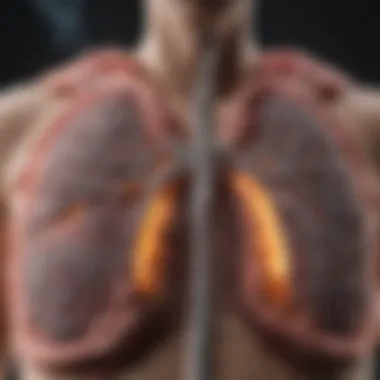Health Risks of Smoking: Lung Cancer, Heart Disease, and More


Intro
Smoking is recognized as a significant public health concern, contributing to an array of health issues. Its impact stretches beyond personal health, affecting families and communities. Understanding the diseases linked to smoking can foster informed choices and better public health strategies. This article will delve into three critical diseases caused by smoking: lung cancer, cardiovascular disease, and respiratory conditions.
Research Overview
Key Findings
Research has consistently shown a strong connection between smoking and the development of severe health issues. Here are some key findings:
- Lung Cancer: Smoking is the primary cause of lung cancer, accounting for approximately 85% of all cases. It significantly increases the risk of developing the disease.
- Cardiovascular Disease: Smokers are at a higher risk for various cardiovascular diseases including heart attacks and strokes. The risk is proportional to the amount smoked.
- Respiratory Conditions: Smoking contributes to chronic obstructive pulmonary disease (COPD) and emphysema, leading to long-term disability and health complications.
"The health implications of smoking extend beyond the individual. Families, communities, and society bear the cost of health care and loss of productivity."
Study Methodology
The studies referenced in this discussion have employed various methodologies to gather data. They include:
- Longitudinal Cohort Studies: Following individuals over time to observe health outcomes related to smoking status.
- Cross-Sectional Studies: Analyzing data at a specific point in time to gauge the prevalence of diseases among smokers versus non-smokers.
- Meta-Analyses: Combining results from multiple studies to provide more robust conclusions about the effects of smoking.
Background and Context
Historical Background
The history of smoking is a long and complex narrative. It has been prevalent for centuries, often associated with cultural rituals and traditions. The 20th century saw a major shift as medical research began to expose the health risks associated with smoking. By the 1950s and 1960s, strong evidence linked smoking to lung cancer and cardiovascular diseases.
Current Trends in the Field
In recent years, smoking rates have declined in many regions due to public health initiatives and increased awareness. However, tobacco use remains a significant problem globally, with new challenges such as vaping emerging. Current trends also show a rise in smoking-related health issues, emphasizing the need for continued education and intervention on the harms of smoking.
Understanding the progression from historical views on smoking to modern-day awareness is crucial for targeting smoking cessation efforts and public health policies.
Prologue to Smoking and Health
Smoking remains a pivotal concern in public health discussions. It is not merely a personal choice but a habit intertwined with various health risks. The consequences of smoking stretch beyond the individual, impacting families, communities, and healthcare systems. This article delves into three major diseases linked to smoking: lung cancer, cardiovascular disease, and respiratory conditions. Understanding these connections is crucial for developing effective prevention strategies and improving health outcomes.
Overview of Smoking
Smoking is the act of inhaling the smoke produced by burning tobacco or other substances. This activity delivers nicotine, a highly addictive substance, along with a myriad of harmful chemicals. These include tar, carbon monoxide, and formaldehyde, among many others. The health implications of these components are substantial, contributing to chronic diseases and complications that are often fatal.
Many people start smoking at a young age, often influenced by social and environmental factors. Initiating this habit can lead to a lifetime of health challenges. Moreover, the addictive nature of nicotine makes cessation difficult, leading to ongoing public health issues. Statistically, smoking is one of the leading causes of preventable death worldwide, which highlights its significance in health discussions.
Global Smoking Statistics
Globally, smoking prevalence varies widely, affected by culture, regulations, and public awareness. According to the World Health Organization, over 1.1 billion people smoke globally. This figure represents nearly one in every five adults.
Some notable statistics include:
- Mortality Rates: Smoking accounts for more than 8 million deaths each year. Of these, over 7 million are attributed to direct tobacco use, while around 1.2 million occur from secondhand smoke exposure.
- Youth Smoking: Nearly 90% of adult smokers initiated the habit before age 18. This underscores the importance of preventing tobacco use among younger populations.
- Economic Impact: The economic cost of smoking-related diseases and loss of productivity is staggering, reaching over $1 trillion annually worldwide.
"The journey to reducing smoking rates requires collaboration between healthcare professionals, policymakers, and communities."


Lung Cancer and Smoking
Lung cancer stands as one of the most significant health issues directly associated with smoking. Not only is it a leading cause of cancer-related mortality worldwide, but it also epitomizes the severe long-term consequences of tobacco use. Understanding lung cancer in the context of smoking helps illuminate the profound impact that lifestyle choices can have on health. Through exploring this relationship, it becomes evident how crucial it is to advocate for smoking cessation and develop targeted public health policies aimed at reducing smoking prevalence.
Etiology of Lung Cancer
The etiology of lung cancer is largely linked to prolonged exposure to carcinogens found in tobacco smoke. Among the many toxic compounds in tobacco, polycyclic aromatic hydrocarbons and nitrosamines are particularly notorious. When inhaled, these substances damage the DNA in lung cells, leading to mutations that can precipitate cancer development. Other risk factors include genetic predisposition, environmental influences, and occupational exposures. However, smoking remains the predominant cause, accounting for approximately 85% of all lung cancer cases.
Pathophysiology of Lung Cancer
Lung cancer primarily manifests through several distinct histological types, including non-small cell lung cancer and small cell lung cancer. In essence, the pathophysiological progression commences with the initial damage to lung epithelial cells due to carcinogens. Over time, this damage results in dysplasia, a precursor to malignant transformation. Cancer cells then exhibit uncontrolled growth, evading the body’s regulatory mechanisms. This aberrant proliferation leads to tumor formation, which often metastasizes to adjacent organs, thereby complicating treatment and reducing survival rates.
Epidemiological Evidence of Smoking-Related Lung Cancer
Numerous studies provide compelling epidemiological evidence linking smoking to lung cancer. The risk of developing lung cancer increases significantly with the duration and intensity of smoking. Smokers are approximately 15 to 30 times more likely to develop lung cancer compared to non-smokers. Data show that even passive exposure to tobacco smoke can lead to an increased risk of developing lung cancer, exemplifying the widespread implications of smoking on community health. According to the American Cancer Society's findings, continued efforts to reduce smoking rates will be crucial in reducing lung cancer incidence globally.
Preventive Measures and Public Health Implications
Preventive measures play a vital role in combating the lung cancer epidemic associated with smoking. These include comprehensive cessation programs, public smoking bans, and increasing taxation on tobacco products. Health education campaigns are essential to raise awareness of the dangers of smoking and to promote healthy lifestyle choices. Furthermore, encouraging regular screenings for high-risk populations can help detect lung cancer at an earlier, more treatable stage. Public health initiatives also need to focus on the importance of legislative measures aimed at reducing tobacco accessibility, especially among youths.
"Effective smoking cessation programs can significantly lessen the burden of lung cancer and related diseases."
In summary, the intersection of lung cancer and smoking underscores the importance of understanding the health consequences of tobacco use. By focusing on the etiology, pathophysiology, epidemiology, and prevention strategies related to lung cancer, it is possible to foster a more informed society that prioritizes health and wellness.
Cardiovascular Disease Associated with Smoking
Cardiovascular disease remains one of the leading causes of morbidity and mortality globally. Smoking is a significant modifiable risk factor for these conditions. By understanding the association between smoking and cardiovascular health, individuals and healthcare providers can better address the preventable nature of many related health issues. This section will analyze how smoking impacts cardiovascular health, the mechanisms that link it to heart disease, relevant statistics, and effective clinical interventions.
The Impact of Smoking on Cardiovascular Health
The impact of smoking on cardiovascular health is profound and multifaceted. When a person smokes, numerous substances enter the body and affect the cardiovascular system. These substances cause inflammation, increase blood pressure, and promote thrombosis, all of which negatively influence heart health. Smokers often experience damage to blood vessels, which can lead to atherosclerosis—a condition characterized by the buildup of plaque in the arteries. The end result is higher risks of heart attack, stroke, and other serious conditions.
Several studies consistently demonstrate that smokers have a higher incidence of cardiovascular events compared to non-smokers. Even secondhand smoke poses risks, impacting not only the smoker but also those exposed to tobacco smoke. Quitting smoking can reverse some of these effects, leading to improvements in cardiovascular health.
Mechanisms Linking Smoking to Heart Disease
The connection between smoking and heart disease is established through several biological mechanisms.
- Oxidative Stress: Cigarette smoke contains free radicals, which increase oxidative stress. This stress damages endothelial cells and promotes inflammation.
- Endothelial Dysfunction: Smoking leads to a reduction in the availability of nitric oxide, a molecule essential for maintaining healthy blood vessel function. This results in impaired vasodilation, contributing to hypertension and increased workload on the heart.
- Cholesterol Changes: Smokers tend to have lower levels of high-density lipoprotein (HDL) cholesterol, often referred to as "good" cholesterol. This imbalance increases the risk of plaque formation in arteries.
- Platelet Activation: Smoking activates platelets, leading to an increased likelihood of clot formation. This can obstruct arteries and result in acute cardiovascular events.
Understanding these mechanisms can guide future therapeutic approaches and inform smoking cessation strategies.
Statistics and Prevalence of Smoking-Related Cardiovascular Disease
The statistical landscape surrounding smoking and cardiovascular disease is alarming. According to the World Health Organization, tobacco use accounts for more than 7 million deaths each year, many resulting from cardiovascular complications. Research indicates that smokers are two to four times more likely to develop coronary heart disease compared to non-smokers. Furthermore, individuals who smoke face a significantly higher risk of cerebrovascular accidents.
Recent data show that approximately 30% of all cardiovascular disease deaths can be attributed to smoking. These figures emphasize the urgent need for public health interventions aimed at reducing smoking prevalence and its associated risks.
Clinical Interventions and Smoking Cessation Strategies
The fight against smoking-related cardiovascular disease involves tailored clinical interventions. Effective smoking cessation strategies include:
- Behavioral Therapies: Cognitive-behavioral therapy and motivational interviewing have shown efficacy in promoting quitting.
- Pharmacotherapy: Medications such as varenicline (Chantix) and bupropion (Zyban) are beneficial in helping individuals quit smoking.
- Support Groups: Access to group therapy and support systems can provide the encouragement needed to cease smoking.
- Public Health Campaigns: Initiatives to raise awareness about the dangers of smoking can drive change at the community level.


According to the U.S. Centers for Disease Control and Prevention, quitting smoking can lead to significant health improvements, reducing the risk of coronary heart disease by half within one year after cessation.
Respiratory Conditions Linked to Smoking
The examination of respiratory conditions linked to smoking is of paramount significance in understanding the broader implications of tobacco use. It sheds light on various diseases that not only affect individual health but also pose challenges for healthcare systems globally. Smoking is a primary factor in the development of respiratory diseases, which include chronic obstructive pulmonary disease (COPD) and emphysema. Understanding these conditions can lead to better prevention strategies, targeted interventions, and an informed public.
Common Respiratory Diseases Associated with Smoking
Smoking is well recognized as a major risk factor for several respiratory diseases. Some of the most notable conditions that arise include:
- Chronic Obstructive Pulmonary Disease (COPD): This is a progressive disease that results in difficulty in breathing, cough, and sputum production. It encompasses emphysema and chronic bronchitis.
- Lung Cancer: Tobacco smoke contains carcinogens that significantly increase the risk of developing lung cancer, which remains one of the deadliest cancers worldwide.
- Asthma: While asthma can have many triggers, smoking exacerbates symptoms and can cause more severe attacks.
- Pneumonia: Smokers are at higher risk for respiratory infections, leading to increased hospitalizations due to pneumonia.
The association of these diseases with smoking is extensive. Each of these conditions contributes to morbidity, discomfort, and increased healthcare costs, making smoking cessation a critical public health goal.
Pathophysiological Changes in the Respiratory System
The impact of smoking on the respiratory system is profound and multifaceted. Smoking causes:
- Inflammation: Smoke irritates the airways, leading to chronic inflammation which is characteristic of COPD and bronchitis.
- Ciliary Dysfunction: The cilia, tiny hair-like structures in the respiratory tract, become impaired and lose their ability to clear mucus and pathogens, increasing infection risk.
- Alveolar Destruction: In emphysema, the alveoli (air sacs in the lungs) are damaged, reducing lung elasticity and capacity. This leads to difficulty in breathing and oxygen exchange.
- Mucus Hypersecretion: Smoking stimulates excessive mucus production, further complicating respiratory conditions and increasing the frequency of coughs.
These changes emphasize the need for early intervention and smoking cessation to mitigate long-term damage and improve quality of life among smokers.
Burden of Respiratory Diseases Linked to Tobacco Use
The burden of respiratory diseases related to smoking is significant. According to the World Health Organization, millions of deaths each year are attributed to tobacco-related respiratory illnesses. The economic impact is also staggering:
- Increased healthcare costs due to hospital stays, treatments, and medications.
- Loss of productivity owing to illness and premature death.
"Respiratory diseases caused by smoking not only affect individuals but also impose considerable economic burdens on societies."
These factors highlight the urgency of addressing smoking at both individual and community levels.
Role of Public Health in Addressing Respiratory Health
Public health initiatives play a vital role in combating the respiratory health crisis linked to smoking. Effective strategies include:
- Educational Campaigns: Raising awareness about the dangers of smoking and secondhand smoke.
- Cessation Programs: Providing support for individuals aiming to quit smoking through counseling, medications, and community programs.
- Policy Implementation: Enforcing smoking bans in public areas and increasing taxes on tobacco products to reduce usage.
- Screening and Early Detection: Promoting regular check-ups for high-risk populations to detect respiratory diseases early.
Collectively, these efforts aim to reduce the incidence of smoking-related respiratory diseases, improve public health outcomes, and decrease the overall burden on healthcare systems.
Comorbidities and the Interconnection of Health Issues
The examination of comorbidities in the context of smoking emerges as a crucial component in understanding the overall consequences on health. Smokers often face multiple health challenges simultaneously, which exacerbates the severity of individual conditions. This section highlights the significance of this interconnection, emphasizing how smoking integrates various health impairments, particularly focusing on respiratory diseases and cardiovascular conditions.
The Link Between Respiratory Disease and Cardiovascular Health
Respiratory diseases, such as chronic obstructive pulmonary disease (COPD) and emphysema, are most commonly known to be linked to smoking. However, these conditions do not exist in isolation. Numerous studies indicate a strong correlation between respiratory illnesses and cardiovascular health. The presence of respiratory disease can lead to systemic inflammation, which significantly increases the risk of heart disease.
Key points to consider include:
- Inflammatory Response: Smoking triggers inflammation in the lungs, which can spill over into the bloodstream, harming blood vessels.
- Hypoxia: Reduced oxygen levels due to poor lung function may place extra strain on the heart, facilitating conditions like heart failure or arrhythmias.
- Shared Risk Factors: Factors such as sedentary lifestyle and poor diet often seen in smokers also contribute to both respiratory and cardiovascular diseases.


Understanding these connections may encourage more comprehensive treatment approaches that address both respiratory and heart health in smokers.
Influence of Smoking on Overall Health Outcomes
Smoking has profound effects on an individual’s overall health outcomes, affecting nearly every organ system in the body. Beyond the well-known impacts on lung health, this behaviors leads to a cascade of health issues. Each condition interacts with others, making them more severe and harder to treat. The consequences of smoking manifest in several ways:
- Chronic Conditions: Smokers are at a greater risk for developing diabetes and complications associated with it.
- Mental Health: There is increasing recognition of the impact smoking has on mental health, influencing mood disorders like anxiety and depression.
- Immune System: Smoking compromises the immune system, making individuals more vulnerable to infections.
The interrelation of these factors suggests a network of health issues stemming from smoking, highlighting the necessity for targeted public health initiatives that not only focus on cessation but also on integrated care.
"Addressing smoking must not only consider cessation strategies but also comprehensively treat the interrelated health conditions it exacerbates."
In summary, the exploration of comorbidities connected to smoking draws attention to the multi-faceted health risks faced by smokers. It encourages a holistic approach not just for public health campaigns but also for medical treatments aimed at this population.
Societal Impacts of Smoking-Related Diseases
The societal implications of smoking-related diseases extend beyond individual health outcomes. These impacts resonate through various layers of community, economy, and healthcare systems. Understanding these consequences is crucial, as it frames the context in which public health policies are developed and implemented. This section delves into two primary aspects: the economic burden on society and the challenges posed to the healthcare system by smoking-related illnesses.
Economic Burden of Smoking-Related Health Issues
The financial toll of smoking-related health issues is staggering. According to several studies, the economic costs associated with smoking can be divided into direct and indirect costs. Direct costs include medical expenses linked to treating diseases caused by smoking. This encompasses hospitalization, outpatient care, and long-term rehabilitation for conditions like lung cancer and heart diseases. In the United States alone, direct medical costs incurred in caring for smokers exceed $170 billion annually.
Indirect costs arise from lost productivity due to premature death, increased rates of disability, and absenteeism. For instance, smokers often face higher rates of sick days compared to non-smokers. Their productivity is also diminished, which places additional strain on businesses and the economy as a whole. The CDC estimates that smoking-related productivity loss accounts for approximately $156 billion each year in the U.S. These financial consequences emphasize the need for effective smoking cessation programs and increased public awareness about the dangers of tobacco use.
- Key economic impacts include:
- Direct medical costs for treating smoking-related diseases
- Loss of productivity due to illness and premature deaths
- Increased insurance premiums and economic burdens on healthcare systems
Healthcare System Challenges Posed by Smoking
Smoking also creates significant challenges for healthcare systems. With rising numbers of individuals diagnosed with smoking-related illnesses, healthcare providers face heightened demands for treatment and resources. Hospitals often deal with an influx of patients with severe respiratory and cardiovascular conditions caused by smoking. This pressure can lead to overcrowded facilities and increased wait times for crucial medical services.
Moreover, the management of chronic diseases linked to smoking requires ongoing care and a comprehensive approach to treatment. This necessity increases operational costs for healthcare facilities and can overwhelm limited resources. For example, managing a patient with chronic obstructive pulmonary disease (COPD) often encompasses regular check-ups, medication management, and potential hospitalizations during exacerbation periods.
The cumulative effect of these challenges necessitates a robust and adaptable healthcare infrastructure. Policies aimed at reducing smoking prevalence and effectively managing existing conditions can alleviate some of these burdens. Collaborative efforts between public health sectors, educational institutions, and healthcare providers are essential to address this complex issue effectively.
"The societal impacts of smoking-related diseases highlight the importance of preventative measures and the critical need for public policy reforms that target tobacco use at its roots."
The End and Future Perspectives
In summary, the health consequences of smoking are profound and multifaceted. This article has examined three critical health issues—lung cancer, cardiovascular disease, and respiratory conditions—demonstrating how smoking plays a central role in their etiology and progression.
Summary of Key Health Problems Caused by Smoking
To effectively combat the health issues caused by smoking, it is essential to highlight their primary aspects:
- Lung Cancer: Smoking is a primary risk factor that significantly increases the likelihood of developing lung cancer. The carcinogens present in tobacco smoke lead to mutations in lung cells, eventually resulting in malignant tumors.
- Cardiovascular Disease: Smokers are at a higher risk of heart disease due to the harmful effects of smoke on blood vessels and heart function. Smoking contributes to atherosclerosis and can result in heart attacks and strokes.
- Respiratory Conditions: Chronic obstructive pulmonary disease (COPD) and emphysema are prevalent among smokers. The inhalation of tobacco smoke leads to inflammation, airway obstruction, and impaired lung function over time.
Addressing these health problems is crucial for public health initiatives. Smoking cessation programs and awareness campaigns can help reduce the incidence of these diseases and improve overall health outcomes.
The Importance of Continued Research and Public Health Efforts
Ongoing research is vital for understanding the complex relationship between smoking and health. Future studies can provide insights into:
- New Treatment Strategies: Innovative therapies for people affected by smoking-related diseases can improve quality of life and survival rates.
- Effective Smoking Cessation Programs: Research can help identify the most effective methods and tools to assist smokers in quitting.
- Policy Development: Informing policymakers on the health burdens caused by smoking can lead to improved regulations and health campaigns.
Public health efforts should focus on the prevention of smoking initiation, promoting cessation, and providing support for those affected. By enhancing our knowledge and tailoring interventions, we can mitigate the health impacts of smoking on individuals and society as a whole.
"Continued investment in public health research and education is paramount in the fight against smoking-related diseases, as it fosters informed discussions and effective interventions."







